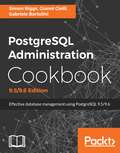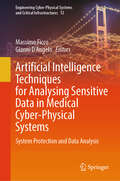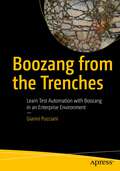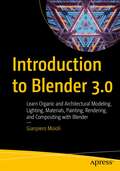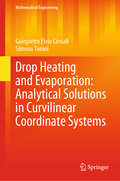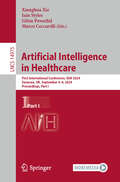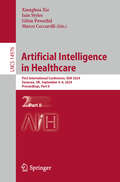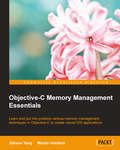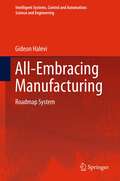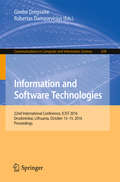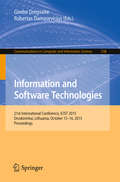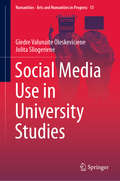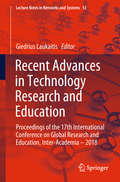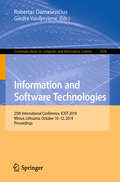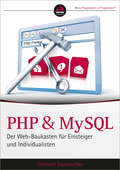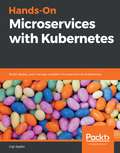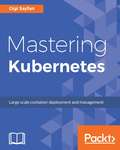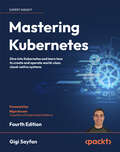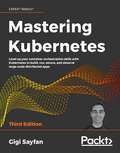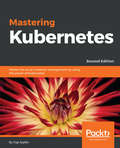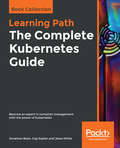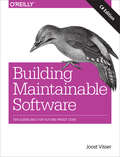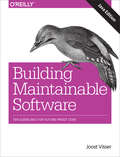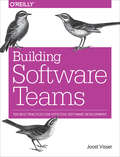- Table View
- List View
PostgreSQL Administration Cookbook - Third Edition
by Simon Riggs Gianni CiolliIf you are an administrator who wants to leverage the useful PostgreSQL functionalities to create and manage databases efficiently, this is the book for you. This book assumes a basic working knowledge of PostgreSQL, and some previous experience in PostgreSQL administration is required.
Artificial Intelligence Techniques for Analysing Sensitive Data in Medical Cyber-Physical Systems: System Protection and Data Analysis (Engineering Cyber-Physical Systems and Critical Infrastructures #12)
by Massimo Ficco Gianni D’AngeloThis book presents the major advances in techniques to preserve privacy and security requirements connected with the use of AI and machine learning (ML) to analyse and manage sensitive data in MCPSs. The advances in Internet of things and artificial intelligence (AI) have witnessed great progress on healthcare technologies in several application domains. In particular, the interconnection between the physical spaces, characterized by physical devices able to collect users’ health information, with the cyberspace, also known as the virtual space, has fostered the development of intelligent Medical Cyber-Physical Systems (MCPSs) with the capability to deliver real-time healthcare services. On the other hand, the potential innovation that these technologies bring to improve patient care, by remotely analysing health parameters using medical devices, advanced smart sensors, and AI, is hampered by security and privacy challenges related to the managed sensitive data. Starting from the state of the art on AI and ML for medical applications and digital health, an accurate analysis of privacy and security risks associated with the use of the MCPSs is presented. Then, Digital Twins are introduced as a significant technique to enhance decision-making through learning and reasoning of collected on-field real-time data. Moreover, decentralized healthcare data management approaches based on federated learning, tiny machine learning, and blockchain technologies have been introduced to shift control and responsibility of healthcare data management from individual centralized entities to a more distributed structure, preserving privacy and security. Finally, the application of AI-based security monitoring approaches in healthcare is discussed. In this book, both theoretical and practical approaches are used to allow readers to understand complex topics and concepts easily also through real-life scenarios.
Boozang from the Trenches: Learn Test Automation with Boozang in an Enterprise Environment
by Gianni PuccianiTest Automation is a key aspect of delivering high-quality software and reducing time to market. Several tools and approaches are available today, each with its own constraints and specificity. This book introduces Boozang, a codeless web automation tool, using a real-life enterprise project as source for examples. You'll have the opportunity to learn the basic features of Boozang and how to implement end-to-end automated scenarios, mixing GUI and API actions. Integration with JIRA-XRay and Jenkins is also covered to show how Boozang can be used effectively in an enterprise environment. The book is filled with examples that go beyond the Boozang tool, and cover the setup of a test automation project in a real context, with practical solutions as well as open points for which we are still looking for new ideas. You will learn how to:· Install and set up a project with Boozang· Create a modular test suite and use Gherkin to define scenarios· Integrate Boozang with JIRA-XRay and work in a team with code branches· Build a Jenkins pipeline to execute the automated scenarios nightly and reduce the execution time via parallelism This Book is for: Testers and test managers, IT projects leads, Release and Delivery Managers, Developers, and Business Analysts
Photovoltaic Sources
by Gianpaolo Vitale Maria Carmela Di PiazzaModeling of photovoltaic sources and their emulation by means of power electronic converters are challenging issues. The former is tied to the knowledge of the electrical behavior of the PV generator; the latter consists in its realization by a suitable power amplifier. This extensive introduction to the modeling of PV generators and their emulation by means of power electronic converters will aid in understanding and improving design and set up of new PV plants. The main benefit of reading Photovoltaic Sources is the ability to face the emulation of photovoltaic generators obtained by the design of a suitable equipment in which voltage and current are the same as in a real source. This is achieved according to the following steps: the source electrical behavior modeling, the power converter design, including its control, for the laboratory emulator. This approach allows the reader to cope with the creation of an indoor virtual photovoltaic plant, in which the environmental conditions can be imposed by the user, for testing real operation including maximum power point tracking, partial shading, control for the grid or load interfacing, etc. Photovoltaic Sources is intended to meet the demands of postgraduate level students, and should prove useful to professional engineers and researchers dealing with the problems associated with modeling and emulation of photovoltaic sources.
Introduction to Blender 3.0: Learn Organic and Architectural Modeling, Lighting, Materials, Painting, Rendering, and Compositing with Blender
by Gianpiero MoioliMaster the basics of 3D modeling for art, architecture, and design by exploring Blender 3.0. This book explains modeling, materials, lighting, painting, and more with Blender and other external tools.You will configure a 3D architectural environment and set up the workflow of an art and design project within Blender. You will use Blender's main tools—mesh modeling and sculpting—to create virtual objects and environments. And, you will explore building materials and light scenes, followed by drawing and virtual painting. Chapters cover rendering scenes and transforming them into 2D images or videos. You will learn to use Blender 3.0 for video editing as a compositor and video sequence editor (VSE or sequencer) with a wide range of effects available through the nodal system.On completing this book, you will have the knowledge to create art, design, and architecture with this 3D modeler.What You Will LearnCreate objects and architectural buildings with different techniques of 3D modelingMaster creating an environment for your objects and how to light themDetermine how to create node materials and assign them to your Blender objectsPick up UV unwrapping and texture paintingGet closer to painting and drawing in BlenderRender your scenes and create stunning videosWho This Book Is ForArtists, designers, architects, and animation artists who want to learn Blender by tackling the challenges of building high-end computer graphics, art, design, and architecture. Ideal for readers with little-to-no experience with Blender as it starts with the basics and covers techniques to produce objects, materials, environments.
Drop Heating and Evaporation: Analytical Solutions in Curvilinear Coordinate Systems (Mathematical Engineering)
by Simona Tonini Gianpietro Elvio CossaliThis book describes analytical methods for modelling drop evaporation, providing the mathematical tools needed in order to generalise transport and constitutive equations and to find analytical solutions in curvilinear coordinate systems. Transport phenomena in gas mixtures are treated in considerable detail, and the basics of differential geometry are introduced in order to describe interface-related transport phenomena. One chapter is solely devoted to the description of sixteen different orthogonal curvilinear coordinate systems, reporting explicitly on the forms of their differential operators (gradient, divergent, curl, Laplacian) and transformation matrices. The book is intended to guide the reader from mathematics, to physical descriptions, and ultimately to engineering applications, in order to demonstrate the effectiveness of applied mathematics when properly adapted to the real world. Though the book primarily addresses the needs of engineering researchers, it will also benefit graduate students.
Artificial Intelligence in Healthcare: First International Conference, AIiH 2024, Swansea, UK, September 4–6, 2024, Proceedings, Part I (Lecture Notes in Computer Science #14975)
by Marco Ceccarelli Xianghua Xie Iain Styles Gibin PowathilThe two-volume set LNCS 14975 + 14976 constitutes the proceedings of the First International Conference on Artificial Intelligence in Healthcare, AIiH 2024, which took place in Swansea, UK, in September 2024. The 47 full papers included in the proceedings were carefully reviewed and selected from 70 submissions. They were organized in the following topical sections: Part I: Personalised Healthcare and Medicine; AI driven early diagnosis and prevention; AI driven robotics for healthcare; AI in mental health; Part II: AI in proactive care and intervention; AI-aided medical imaging and analysis; Medical signal and image processing; Assisted living technology; Digital twinning, virtual pathology and oncology; Patient data, privacy and ethics.
Artificial Intelligence in Healthcare: First International Conference, AIiH 2024, Swansea, UK, September 4–6, 2024, Proceedings, Part II (Lecture Notes in Computer Science #14976)
by Marco Ceccarelli Xianghua Xie Iain Styles Gibin PowathilThe two-volume set LNCS 14975 + 14976 constitutes the proceedings of the First International Conference on Artificial Intelligence in Healthcare, AIiH 2024, which took place in Swansea, UK, in September 2024. The 47 full papers included in the proceedings were carefully reviewed and selected from 70 submissions. They were organized in the following topical sections: Part I: Personalised Healthcare and Medicine; AI driven early diagnosis and prevention; AI driven robotics for healthcare; AI in mental health; Part II: AI in proactive care and intervention; AI-aided medical imaging and analysis; Medical signal and image processing; Assisted living technology; Digital twinning, virtual pathology and oncology; Patient data, privacy and ethics.
Objective-C Memory Management Essentials
by Gibson Tang Maxim VasilkovIf you are new to Objective-C or a veteran in iOS application development, this is the book for you. This book will ensure that you can actively learn the methods and concepts in relation to memory management in a more engaging way. Basic knowledge of iOS development is required for this book.
All-Embracing Manufacturing: Roadmap System (Intelligent Systems, Control and Automation: Science and Engineering #59)
by Gideon HaleviAll-embracing manufacturing is a system that aims to dissolve the complexity of the manufacturing process and restore the inherent simplicity. It claims that production is very simple and flexible by nature. However, the complexity is a result of the production system approach which makes it rigid and therefore complex. All-embracing manufacturing introduces flexibility to production planning, it eliminates constraints, bottlenecks, and disruptions automatically while it restores the simplicity. No decision is made ahead of time, but only at the time of execution. It introduces technology as dominant part of manufacturing. It is a computer oriented system that imitates human behavior i.e. practically as any of us behave in daily personal life.
Information and Software Technologies
by Giedre Dregvaite Robertas DamaseviciusThis book constitutes the refereed proceedings of the 20th International Conference on Information and Software Technologies, ICIST 2014, held in Druskininkai, Lithuania, in October 2014. The 34 papers presented were carefully reviewed and selected from 68 submissions. The papers are organized in topical sections such as information systems; business intelligence for information and software systems; software engineering; information technology applications.
Information and Software Technologies: 21st International Conference, Icist 2015, Druskininkai, Lithuania, October 15-16, 2015, Proceedings (Communications In Computer And Information Science #538)
by Giedre Dregvaite Robertas DamaseviciusThis book constitutes the refereed proceedings of the 21th International Conference on Information and Software Technologies, ICIST 2015, held in Druskininkai, Lithuania, in October 2015. The 51 papers presented were carefully reviewed and selected from 125 submissions. The papers are organized in topical sections on information systems; business intelligence for information and software systems; software engineering; information technology applications.
Social Media Use in University Studies (Numanities - Arts and Humanities in Progress #13)
by Jolita Sliogeriene Giedre Valunaite OleskevicieneThis book highlights the phenomenon of social media use in university studies based on its participants’ lived experience. It will appeal both to academics and practitioners interested in the human factors in the study environments saturated with technologies of social media. This book reveals multiple, sometimes contradictory dimensions of the phenomenon. The contradictions acquire a binary Janus-faced characteristic of uncertainty and paradox. Social media use in university studies also causes changes in experiencing time, space and relations. Teacher research participants sometimes perceive their time as stress or an additional load, which shows that social media use in university studies demands a new approach to teacher workload and its regulation. There is also the necessity of the sensitive democratic teacher—student pedagogical relationship. This book proves that the pedagogical relationship and human creativity essentially belong to the human living world and are still at the heart of the technological “cyborgian” existence.
Recent Advances in Technology Research and Education: Proceedings Of The 17th International Conference On Global Research And Education Inter-academia - 2018 (Lecture Notes in Networks and Systems #53)
by Giedrius LaukaitisThis book presents the proceedings of the 17th International Conference on Global Research and Education, Inter-Academia 2018 held in Kaunas, Lithuania on 24–27 September 2018. The main goal of the conference was to provide an international forum to review, stimulate, and understand the recent trends in both fundamental and applied research. In addition to increasing interest in recent research findings, the conference aimed to strengthen the cooperation between the partners of the Inter-Academia community towards new theoretical and practical research advances. The papers included cover topics in the fields of material science and technology, nanotechnology, plasma physics, biotechnology and environmental engineering, electric and electronic engineering, robotics, measurement, identification, and control, soft computing techniques and modeling, multimedia and e-Learning. The book is a valuable scientific reference resource for the global scientific community.
Information and Software Technologies: 25th International Conference, ICIST 2019, Vilnius, Lithuania, October 10–12, 2019, Proceedings (Communications in Computer and Information Science #1078)
by Robertas Damaševičius Giedrė VasiljevienėThis book constitutes the refereed proceedings of the 25th International Conference on Information and Software Technologies, ICIST 2019, held in Vilnius, Lithuania, in October 2019.The 46 papers presented were carefully reviewed and selected from 121 submissions. The papers are organized in topical sections on information systems; business intelligence for information and software systems; information technology applications; software engineering.
PHP und MySQL: Der Web-Baukasten für Einsteiger und Individualisten
by Giesbert DamaschkeSie haben schon eigene Webseiten gebaut und möchten diese nun mit Funktionen ausstatten, für die Sie PHP und MySQL benötigen? Giesbert Damaschke zeigt Ihnen in diesem Buch, wie Sie das schaffen. Schritt für Schritt erlernen Sie die benötigten Programmier- und Datenbankgrundlagen - immer im Rahmen von typischen dynamischen Anwendungen. So erheben und speichern Sie zum Beispiel mit Formularen Kontaktdaten, prüfen Benutzereingaben, erstellen Menüs, richten einen Besucherzähler ein, verschicken E-Mails mit PHP oder entwickeln sogar einen eigenen Blog. Alle Codebeispiele werden ausführlich erklärt, sodass Sie sich schnell zurechtfinden werden, wenn Sie ein wenig HTML und CSS beherrschen. Programmier- oder Datenbankkenntnisse werden nicht vorausgesetzt. Jedes Kapitel bietet Ihnen Übungsaufgaben, an denen Sie Ihr neu gewonnenes PHP- und MySQL-Wissen praktisch testen können. Die lauffähigen Musterlösungen können Sie zusammen mit den Beispieldateien herunterladen, um sich daran zu orientieren oder auch gleich in Ihre Website einzubauen. So gelingt Ihnen der Einstieg in PHP und MySQL mit Sicherheit!
Hands-On Microservices with Kubernetes: Build, deploy, and manage scalable microservices on Kubernetes
by Gigi SayfanEnhance your skills in building scalable infrastructure for your cloud-based applications Key Features Learn to design a scalable architecture by building continuous integration (CI) pipelines with Kubernetes Get an in-depth understanding of role-based access control (RBAC), continuous deployment (CD), and observability Monitor a Kubernetes cluster with Prometheus and Grafana Book Description Kubernetes is among the most popular open-source platforms for automating the deployment, scaling, and operations of application containers across clusters of hosts, providing a container-centric infrastructure. Hands-On Microservices with Kubernetes starts by providing you with in-depth insights into the synergy between Kubernetes and microservices. You will learn how to use Delinkcious, which will serve as a live lab throughout the book to help you understand microservices and Kubernetes concepts in the context of a real-world application. Next, you will get up to speed with setting up a CI/CD pipeline and configuring microservices using Kubernetes ConfigMaps. As you cover later chapters, you will gain hands-on experience in securing microservices, and implementing REST, gRPC APIs, and a Delinkcious data store. In addition to this, you'll explore the Nuclio project, run a serverless task on Kubernetes, and manage and implement data-intensive tests. Toward the concluding chapters, you'll deploy microservices on Kubernetes and learn to maintain a well-monitored system. Finally, you'll discover the importance of service meshes and how to incorporate Istio into the Delinkcious cluster. By the end of this book, you'll have gained the skills you need to implement microservices on Kubernetes with the help of effective tools and best practices. What you will learn Understand the synergy between Kubernetes and microservices Create a complete CI/CD pipeline for your microservices on Kubernetes Develop microservices on Kubernetes with the Go kit framework using best practices Manage and monitor your system using Kubernetes and open-source tools Expose your services through REST and gRPC APIs Implement and deploy serverless functions as a service Externalize authentication, authorization and traffic shaping using a service mesh Run a Kubernetes cluster in the cloud on Google Kubernetes Engine Who this book is for This book is for developers, DevOps engineers, or anyone who wants to develop large-scale microservice-based systems on top of Kubernetes. If you are looking to use Kubernetes on live production projects or want to migrate existing systems to a modern containerized microservices system, then this book is for you. Coding skills, together with some knowledge of Docker, Kubernetes, and cloud concepts will be useful.
Mastering Kubernetes
by Gigi SayfanMaster the art of container management utilizing the power of Kubernetes. About This Book • This practical guide demystifies Kubernetes and ensures that your clusters are always available, scalable, and up to date • Discover new features such as autoscaling, rolling updates, resource quotas, and cluster size • Master the skills of designing and deploying large clusters on various cloud platforms Who This Book Is For The book is for system administrators and developers who have intermediate level of knowledge with Kubernetes and are now waiting to master its advanced features. You should also have basic networking knowledge. This advanced-level book provides a pathway to master Kubernetes. What You Will Learn • Architect a robust Kubernetes cluster for long-time operation • Discover the advantages of running Kubernetes on GCE, AWS, Azure, and bare metal • See the identity model of Kubernetes and options for cluster federation • Monitor and troubleshoot Kubernetes clusters and run a highly available Kubernetes • Create and configure custom Kubernetes resources and use third-party resources in your automation workflows • Discover the art of running complex stateful applications in your container environment • Deliver applications as standard packages In Detail Kubernetes is an open source system to automate the deployment, scaling, and management of containerized applications. If you are running more than just a few containers or want automated management of your containers, you need Kubernetes. This book mainly focuses on the advanced management of Kubernetes clusters. It covers problems that arise when you start using container orchestration in production. We start by giving you an overview of the guiding principles in Kubernetes design and show you the best practises in the fields of security, high availability, and cluster federation. You will discover how to run complex stateful microservices on Kubernetes including advanced features as horizontal pod autoscaling, rolling updates, resource quotas, and persistent storage back ends. Using real-world use cases, we explain the options for network configuration and provides guidelines on how to set up, operate, and troubleshoot various Kubernetes networking plugins. Finally, we cover custom resource development and utilization in automation and maintenance workflows. By the end of this book, you'll know everything you need to know to go from intermediate to advanced level. Style and approach Delving into the design of the Kubernetes platform, the reader will be exposed to the advanced features and best practices of Kubernetes. This book will be an advanced level book which will provide a pathway to master Kubernetes
Mastering Kubernetes: Dive into Kubernetes and learn how to create and operate world-class cloud-native systems
by Gigi SayfanGo beyond the basics of Kubernetes and explore more advanced concepts, including Kubernetes in production, governance, serverless computing, and service meshes. Purchase of the print or Kindle book includes a free eBook in PDF format.Key FeaturesMaster Kubernetes architecture and design to build, deploy, and secure large-scale distributed systemsLearn advanced concepts like autoscaling, multi-cluster management, serverless computing, service meshes and policy enginesExplore Kubernetes 1.25 and its rich ecosystem of tools like Kubectl, Krew, K9s, Lens, and HelmBook DescriptionThe fourth edition of the bestseller Mastering Kubernetes includes the most recent tools and code to enable you to learn the latest features of Kubernetes 1.25. This book contains a thorough exploration of complex concepts and best practices to help you master the skills of designing and deploying large-scale distributed systems on Kubernetes clusters. You’ll learn how to run complex stateless and stateful microservices on Kubernetes, including advanced features such as horizontal pod autoscaling, rolling updates, resource quotas, and persistent storage backends. In addition, you’ll understand how to utilize serverless computing and service meshes. Further, two new chapters have been added. “Governing Kubernetes” covers the problem of policy management, how admission control addresses it, and how policy engines provide a powerful governance solution. “Running Kubernetes in Production” shows you what it takes to run Kubernetes at scale across multiple cloud providers, multiple geographical regions, and multiple clusters, and it also explains how to handle topics such as upgrades, capacity planning, dealing with cloud provider limits/quotas, and cost management. By the end of this Kubernetes book, you’ll have a strong understanding of, and hands-on experience with, a wide range of Kubernetes capabilities.What you will learnLearn how to govern Kubernetes using policy enginesLearn what it takes to run Kubernetes in production and at scaleBuild and run stateful applications and complex microservicesMaster Kubernetes networking with services, Ingress objects, load balancers, and service meshesAchieve high availability for your Kubernetes clustersImprove Kubernetes observability with tools such as Prometheus, Grafana, and JaegerExtend Kubernetes with the Kubernetes API, plugins, and webhooksWho this book is forIf you're a system administrator or cloud developer who wants to become comfortable with Kubernetes and would like to master its advanced features, then this book is for you. Software and DevOps engineers with a working knowledge of Kubernetes, as well as technical managers of Kubernetes-based systems, will also find this book useful. Those deciding on whether to migrate to Kubernetes and are curious about its inner workings will find plenty of answers here as well. Basic familiarity with networking concepts will prove beneficial.
Mastering Kubernetes: Level up your container orchestration skills with Kubernetes to build, run, secure, and observe large-scale distributed apps, 3rd Edition
by Gigi SayfanGo beyond simply learning Kubernetes fundamentals and its deployment, and explore more advanced concepts, including serverless computing and service meshes with the latest updates Key Features Master Kubernetes architecture and design to build and deploy secure distributed applications Learn advanced concepts like autoscaling, cluster federation, serverless computing, and service mesh integration for observability Explore Kubernetes 1.18 features and its rich ecosystem of tools like Kubectl, Knative, and Helm Book Description The third edition of Mastering Kubernetes is updated with the latest tools and code enabling you to learn Kubernetes 1.18's latest features. This book primarily concentrates on diving deeply into complex concepts and Kubernetes best practices to help you master the skills of designing and deploying large clusters on various cloud platforms. The book trains you to run complex stateful microservices on Kubernetes including advanced features such as horizontal pod autoscaling, rolling updates, resource quotas, and persistent storage backend. With the two new chapters, you will gain expertise in serverless computing and utilizing service meshes. As you proceed through the chapters, you will explore different options for network configuration and learn to set up, operate, and troubleshoot Kubernetes networking plugins through real-world use cases. Furthermore, you will understand the mechanisms of custom resource development and its utilization in automation and maintenance workflows. By the end of this Kubernetes book, you will graduate from an intermediate to advanced Kubernetes professional. What you will learn Master the fundamentals of Kubernetes architecture and design Build and run stateful applications and complex microservices on Kubernetes Use tools like Kubectl, secrets, and Helm to manage resources and storage Master Kubernetes Networking with load balancing options like Ingress Achieve high-availability Kubernetes clusters Improve Kubernetes observability with tools like Prometheus, Grafana, and Jaeger Extend Kubernetes working with Kubernetes API, plugins, and webhooks Who this book is for If you are a system administrator or a cloud developer with working knowledge of Kubernetes and are keen to master its advanced features, along with learning everything from building microservices to utilizing service meshes, Mastering Kubernetes is for you. Basic familiarity with networking concepts will be helpful.
Mastering Kubernetes: Master the art of container management by using the power of Kubernetes, 2nd Edition
by Gigi SayfanExploit design, deployment, and management of large-scale containersKey FeaturesExplore the latest features available in Kubernetes 1.10Ensure that your clusters are always available, scalable, and up to dateMaster the skills of designing and deploying large clusters on various cloud platformsBook DescriptionKubernetes is an open source system that is used to automate the deployment, scaling, and management of containerized applications. If you are running more containers or want automated management of your containers, you need Kubernetes at your disposal. To put things into perspective, Mastering Kubernetes walks you through the advanced management of Kubernetes clusters.To start with, you will learn the fundamentals of both Kubernetes architecture and Kubernetes design in detail. You will discover how to run complex stateful microservices on Kubernetes including advanced features such as horizontal pod autoscaling, rolling updates, resource quotas, and persistent storage backend. Using real-world use cases, you will explore the options for network configuration, and understand how to set up, operate, and troubleshoot various Kubernetes networking plugins. In addition to this, you will get to grips with custom resource development and utilization in automation and maintenance workflows.To scale up your knowledge of Kubernetes, you will encounter some additional concepts based on the Kubernetes 1.10 release, such as Promethus, Role-based access control, API aggregation, and more. By the end of this book, you’ll know everything you need to graduate from intermediate to advanced level of understanding Kubernetes.What you will learnArchitect a robust Kubernetes cluster for long-time operationDiscover the advantages of running Kubernetes on GCE, AWS, Azure, and bare metalUnderstand the identity model of Kubernetes, along with the options for cluster federationMonitor and troubleshoot Kubernetes clusters and run a highly available KubernetesCreate and configure custom Kubernetes resources and use third-party resources in your automation workflowsEnjoy the art of running complex stateful applications in your container environmentDeliver applications as standard packagesWho this book is forMastering Kubernetes is for you if you are a system administrator or a developer who has an intermediate understanding of Kubernetes and wish to master its advanced features. Basic knowledge of networking would also be helpful. In all, this advanced-level book provides a smooth pathway to mastering Kubernetes.
The Complete Kubernetes Guide: Become an expert in container management with the power of Kubernetes
by Jonathan Baier Gigi Sayfan Jesse WhiteDesign, deploy, and manage large-scale containers using KubernetesKey FeaturesGain insight into the latest features of Kubernetes, including Prometheus and API aggregationDiscover ways to keep your clusters always available, scalable, and up-to-dateMaster the skills of designing and deploying large clusters on various cloud platformsBook DescriptionIf you are running a number of containers and want to be able to automate the way they’re managed, it can be helpful to have Kubernetes at your disposal. This Learning Path guides you through core Kubernetes constructs, such as pods, services, replica sets, replication controllers, and labels. You'll get started by learning how to integrate your build pipeline and deployments in a Kubernetes cluster. As you cover more chapters in the Learning Path, you'll get up to speed with orchestrating updates behind the scenes, avoiding downtime on your cluster, and dealing with underlying cloud provider instability in your cluster. With the help of real-world use cases, you'll also explore options for network configuration, and understand how to set up, operate, and troubleshoot various Kubernetes networking plugins. In addition to this, you'll gain insights into custom resource development and utilization in automation and maintenance workflows.By the end of this Learning Path, you'll have the expertise you need to progress from an intermediate to an advanced level of understanding Kubernetes.This Learning Path includes content from the following Packt products:Getting Started with Kubernetes - Third Edition by Jonathan Baier and Jesse WhiteMastering Kubernetes - Second Edition by Gigi SayfanWhat you will learnDownload, install, and configure the Kubernetes code baseCreate and configure custom Kubernetes resources Use third-party resources in your automation workflowsDeliver applications as standard packagesSet up and access monitoring and logging for Kubernetes clustersSet up external access to applications running in the clusterManage and scale Kubernetes with hosted platforms on Amazon Web Services (AWS), Azure, and Google Cloud Platform (GCP)Run multiple clusters and manage them from a single control planeWho this book is forIf you are a developer or a system administrator with an intermediate understanding of Kubernetes and want to master its advanced features, then this book is for you. Basic knowledge of networking is required to easily understand the concepts explained.
Building Maintainable Software, C# Edition: Ten Guidelines for Future-Proof Code
by Rob van der Leek Gijs Wijnholds Joost Visser Sylvan Rigal Pascal Van EckHave you ever felt frustrated working with someone else’s code? Difficult-to-maintain source code is a big problem in software development today, leading to costly delays and defects. Be part of the solution. With this practical book, you’ll learn 10 easy-to-follow guidelines for delivering C# software that’s easy to maintain and adapt. These guidelines have been derived from analyzing hundreds of real-world systems.Written by consultants from the Software Improvement Group (SIG), this book provides clear and concise explanations, with advice for turning the guidelines into practice. Examples for this edition are written in C#, while our companion Java book provides clear examples in that language.Write short units of code: limit the length of methods and constructorsWrite simple units of code: limit the number of branch points per methodWrite code once, rather than risk copying buggy codeKeep unit interfaces small by extracting parameters into objectsSeparate concerns to avoid building large classesCouple architecture components looselyBalance the number and size of top-level components in your codeKeep your codebase as small as possibleAutomate tests for your codebaseWrite clean code, avoiding "code smells" that indicate deeper problems
Building Maintainable Software, Java Edition: Ten Guidelines for Future-Proof Code
by Rob van der Leek Gijs Wijnholds Joost Visser Sylvan Rigal Pascal Van EckHave you ever felt frustrated working with someone else’s code? Difficult-to-maintain source code is a big problem in software development today, leading to costly delays and defects. Be part of the solution. With this practical book, you’ll learn 10 easy-to-follow guidelines for delivering Java software that’s easy to maintain and adapt. These guidelines have been derived from analyzing hundreds of real-world systems.Written by consultants from the Software Improvement Group (SIG), this book provides clear and concise explanations, with advice for turning the guidelines into practice. Examples for this edition are written in Java, while our companion C# book provides workable examples in that language.Write short units of code: limit the length of methods and constructorsWrite simple units of code: limit the number of branch points per methodWrite code once, rather than risk copying buggy codeKeep unit interfaces small by extracting parameters into objectsSeparate concerns to avoid building large classesCouple architecture components looselyBalance the number and size of top-level components in your codeKeep your codebase as small as possibleAutomate tests for your codebaseWrite clean code, avoiding "code smells" that indicate deeper problems
Building Software Teams: Ten Best Practices for Effective Software Development
by Gijs Wijnholds Joost Visser Sylvan Rigal Zeeger LubsenWhy does poor software quality continue to plague enterprises of all sizes in all industries? Part of the problem lies with the process, rather than individual developers. This practical guide provides ten best practices to help team leaders create an effective working environment through key adjustments to their process.As a follow-up to their popular book, Building Maintainable Software, consultants with the Software Improvement Group (SIG) offer critical lessons based on their assessment of development processes used by hundreds of software teams. Each practice includes examples of goalsetting to help you choose the right metrics for your team.Achieve development goals by determining meaningful metrics with the Goal-Question-Metric approachTranslate those goals to a verifiable Definition of DoneManage code versions for consistent and predictable modificationControl separate environments for each stage in the development pipelineAutomate tests as much as possible and steer their guidelines and expectationsLet the Continuous Integration server do much of the hard work for youAutomate the process of pushing code through the pipelineDefine development process standards to improve consistency and simplicityManage dependencies on third party code to keep your software consistent and up to dateDocument only the most necessary and current knowledge
